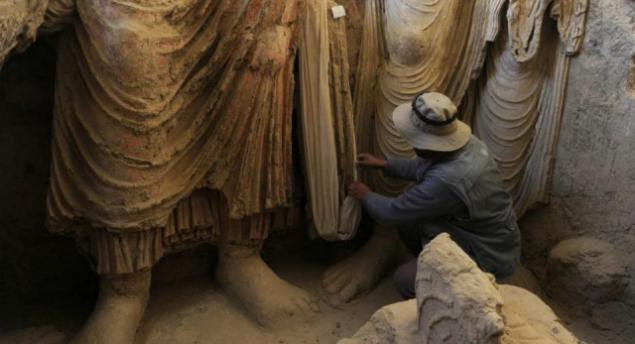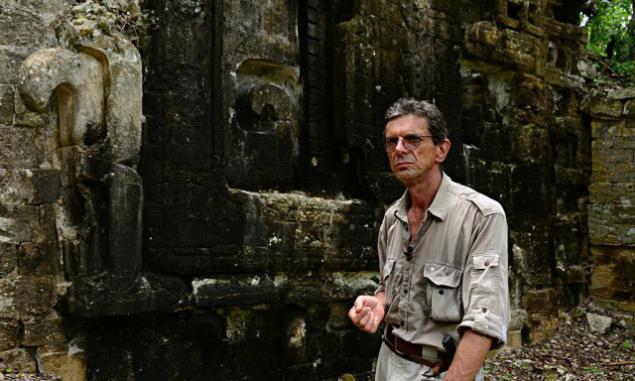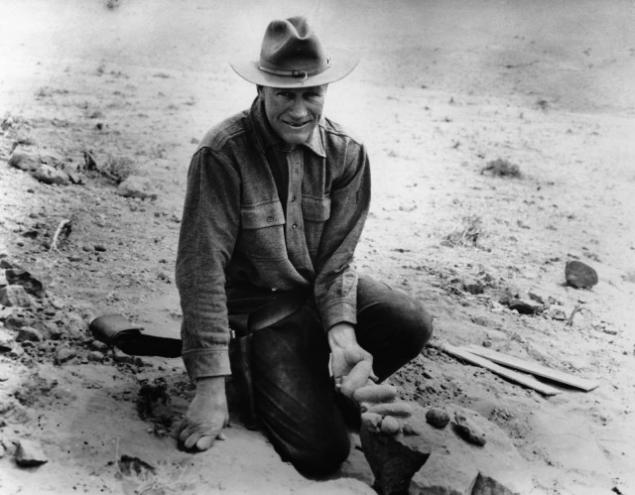990
10 wildest adventurers
Outdo Indiana DzhonsaDoktor Henry Thomas Jones, better known as Indiana Jones, is one of the most beloved characters in movie history. Although both the director, Steven Spielberg and George Lucas, said that Dr. Jones has no real prototype, there are a few people that have passed through the amazing adventures in the pursuit of knowledge, while others risked life and limb just to satisfy their curiosity.
1. Wendell FillipsRodilsya in 1922 and received a degree in paleontology in 1943. Phillips was 27 years old when he went on his first expedition in Africa. A year later, it was made his most famous expedition - he led his team to a remote part of the Arabian desert, in the place which is now known as Yemen. The expedition was sponsored by Dodge and Coca-Cola, Phillips and led his team to the excavations of two large areas. The first was Tynna, the state capital Qataban second - Marib, which was apparently the home of the Queen of Sheba.

site in Marib where excavations were carried out, was in the area not controlled by Britain. Not only that, the expedition worked in an inhospitable environment, so also had to excavate, without causing irritation among local tribes. One man was beaten with rifle butts, the second was kept 28 days in captivity. Phillips left the group of Marib, where the natives began firing their rifles over their heads. In Marib Phillips never returned, but the results of his expedition is very important for studying the history of the Middle East.
2. Kadir TemoriV 2007 the Afghan government sold the mining rights of the Chinese copper mining company. To get to the copper deposits of $ 100 billion, it was necessary to conduct archaeological excavations-Mes Aynak complex. Mes Aynak, in the 2000-year-old is Buddhist city, and some artifacts found there are between the ages of about 5,000 years.

When it sold the right to mine, excavated only about 10% of the territory. Temori Kadeer, head of the Afghan Archaeological Department in Kabul knew that he and his team have very little time, and they were digging as much as possible. Temori had to shy away from the pressure of the Chinese company, to avoid clashes with the Taliban and deal with a hostile government in Afghanistan. The complex had virtually destroyed in 2013, but the development of copper moved to the end of 2015. Desperate Temori action in an attempt to continue the excavations formed the basis of the documentary "Saving Mes Aynak,».
3. Farish DzhenkinsRodilsya in 1940 in Manhattan. He served as an artillery officer in the Marines, then attended Yale University, graduating with a PhD. He considered himself a paleontologist, but have extensive knowledge in related fields - anatomy, zoology and vertebrate paleontology.
After graduating from Yale, he became a professor at Harvard, where he showed himself as a charming and charismatic teacher. Jenkins was known as a very colorful character - he wore a cap of the Czechoslovak rabbit fur, sporting a pocket watch, a flask of vodka and a gun.

His field work began in Africa. Once he was photographed next to a black rhino and rhino attacked him. Fortunately, Farish was able to avoid injury.
Then he went to northern Canada and Greenland to collect fossils, working in extreme weather conditions, and adjacent to the polar bears.

One of its main findings - fossil, known as Tiktaalik - a fish with the beginnings of the feet, ears and snout, lived 375 million years ago. It serves as proof of the release of sea creatures on land.
4. Jim Patton PattonDzhim more than 40 years has been a curator at the Museum of Vertebrate Zoology at UC Berkeley. Throughout his career, Patton went to a remote part of the world for the study of mammals and five times shipwrecked.

The first and most dramatic downfall occurred in 1966 off the coast of Mexico, when he was still a student. Patton and the Mexican fisherman on a small sailing boat. When they hit the storm almost sank their boat. The boat eventually crashed on the rocks in the bay, where they are within 10 days of fighting for life.
On another occasion, off the coast of Costa Rica, his boat caught fire. He spent a lot of time on the liferaft with 13 crew members.
The last crash happened in 1992, on the Amazon River in Brazil, when his boat sank in less than a minute.
5. Ivan SpraytsNesmotrya to modern technology, there is still a lot of the world's unexplored areas, particularly in South America. Due to the denseness of the Amazon rainforest most of the expeditions carried out on land.
Ivan Srayts, associate professor of the Slovenian Academy of Sciences and Arts, went to university in Mexico, where he received a doctorate in anthropology. Since then, he's looking for the ruins of the Mayan civilization.

Travel through dense jungle with a machete unsafe. During his trips, he ran into jaguars and pumas, but the greatest danger were poisonous snakes and insects.
The latter can infect people of leishmaniasis, which causes terrible sores on the skin and the deadly Chagas disease. Sprayts says that "it's hard work, but very romantic».
6. Hiram Bingham IIIHayram Bingham was born in Hawaii and received his doctorate at Harvard. In 1906 he began to study remote areas of South America, and in 1907 he received a teaching position at Yale University.

The most famous of his journey took place in 1911, when he studied in the search for Vitcos Peru, the ancient Inca capital. The Peruvian government has offered Bingham inspect some ruins. There, his expedition ran into a number of walls. It was the ancient Inca city of Machu Picchu. Although there is some disagreement as to who first discovered Machu Picchu, Bingham was certainly the first who announced his discovery. Today, Machu Picchu - a world heritage site and is considered one of the most important archaeological sites from among the ever discovered.
7. William Montgomery MakgovernUilyam Montgomery McGovern was born in 1897 in Manhattan, he has spent most of his childhood in Asia. More child's mother took him with her to Mexico, where he witnessed the revolution. At age 20 he received a theology degree in Buddhist temple in Kyoto, and at age 22 - a PhD in Oxford. By this time he was fluent in 17 languages.

After graduation McGovern went to explore remote parts of the world. His first adventure - the "forbidden city" of Lhasa in Tibet. He crossed the Himalayas, but during the expedition fell ill with dysentery. However, the disguise, he was able to penetrate into the city - the juice walnuts made his skin is darker, and lemon juice hid the blue color of his eyes. Stealth complement clothing servants.
He became, if not the first, one of the first white men who had entered the Forbidden City. There he was in a local hospital. When the monks found that the city made the way an outsider, they surrounded the hospital and began to pelt her with stones. McGovern again disguised, he left the hospital and joined a mob throwing stones.
A few years later, he again spent two years in search of the ruins left by the Inca civilization in the Amazon. McGovern lost one member of the group (he drowned), and then he had a chance to visit the deadly "arms' length anaconda 8, 5 meters. For a while McGovern and his team were forced to survive by eating only meat of monkeys. One day, he took part in the ceremony of the local tribe, during which he was forced to drink hallucinogenic mixture.
McGovern subsequently left the life of an adventurer, and at age 32 he became a professor at Northwestern University. He taught political science, and thanks to its unique knowledge of Asia was appointed special advisor to President Roosevelt during World War II.
8. Percy FosettPersi Fawcett was born in 1867 in a family of adventurers and travelers. Before his travels, he served in the Royal Artillery, and then went to work for the British secret service. In 1901 he started mapping for the Royal Geographical Society. In 1906, he went to his first of seven trips to South America. He made several important geographical discoveries, studying previously unexplored areas of the continent.

Fossett saw amazing for the people of the early 20th century, things like 18, 5-foot anaconda and giant spiders Apazauca. His reports on trips to the Amazon have inspired Sir Arthur Conan Doyle, a friend of Fawcett, write a science fiction novel "The Lost World».
Fawcett has become known in connection with his theory of the lost city Z. studying ancient records and legends, it is believed that the traces of the lost civilization hidden somewhere in the Brazilian Amazon. Funded by the financial group Glove, Fawcett and his elder son Jack, another Raylega Rimell and two Brazilian workers April 20, 1925 he went in search of the lost city. May 29th wife received a telegram from him. She was the last one who saw or heard something about Fawcett and his team.
Since then, many travelers were trying to trace the route of Percy Fawcett, to find out what happened. It is believed that he either died from the disease or been killed by the natives.
9. Roy Chapman Andrews EndryusRoy Chapman was born in Wisconsin in 1884, finished his studies in 1906 and got a job at the American Museum of Natural History. His main passion was the study of marine life, and he traveled to Alaska, Indonesia, China, Japan and Korea to observe life and collect the bones.

When traveling, it is at least 10 times narrowly escaped death. Once he was nearly bitten by wild dogs, then there was an unpleasant encounter with a python and nearly killed by bandits.

Andrews became famous after several expeditions to the Gobi Desert. During the first expedition the researchers found dinosaur bones. During the second discovered fossils of mammals of the same age, which is incredibly rare. And during the third expedition Andrews and his team found fossilized dinosaur eggs. Experts have long believed that dinosaurs laid eggs, but that there was no evidence.
Andrews has written several popular books about his expeditions, and in 1934 became director of the American Museum of Natural History.
10. Otto RanOdnim possible prototypes of the main Indiana Jones was the German Otto Rahn. Run - a legendary personality, and no one is sure that the information on it is correct. He was born in 1904 and from an early age was obsessed with the search for the Holy Grail.

While studying at the University Run delved into the study of a small Christian sect of the Cathars, who allegedly kept the sacred chalice. The Cathars were destroyed in 1244, but Rahn believed that three of the Cathars fled. In 1931, Ran went to the Languedoc, where once lived the Cathars, and discovered a complex system of caves, which they used as underground churches.
Ran wrote a book about his travels - "crusade against the Grail." The book attracted the attention of Heinrich Himmler, the head of the SS. Like Run, Himmler was obsessed with finding the sacred artifact. He wanted to Run took up his research under the aegis of the SS.

So Ran, who was gay, joined the SS. The hunt for the Holy Grail was not a success, and Himmler was disappointed. After the wound was accused of homosexual contact, Himmler sent him a guard at Dachau. That Ran saw in a concentration camp, made him a profound disgust, and he sent in his resignation to Himmler.
According to the official, Otto Rahn in March 1939 committed suicide by taking cyanide. In other versions, he was murdered by agents of the SS or faked his own death. Another option - committed ritual suicide in the tradition of the Cathars.
via www.toptenz.net/10-real-life-adventurers-who-make-indiana-jones-look-boring.php
1. Wendell FillipsRodilsya in 1922 and received a degree in paleontology in 1943. Phillips was 27 years old when he went on his first expedition in Africa. A year later, it was made his most famous expedition - he led his team to a remote part of the Arabian desert, in the place which is now known as Yemen. The expedition was sponsored by Dodge and Coca-Cola, Phillips and led his team to the excavations of two large areas. The first was Tynna, the state capital Qataban second - Marib, which was apparently the home of the Queen of Sheba.

site in Marib where excavations were carried out, was in the area not controlled by Britain. Not only that, the expedition worked in an inhospitable environment, so also had to excavate, without causing irritation among local tribes. One man was beaten with rifle butts, the second was kept 28 days in captivity. Phillips left the group of Marib, where the natives began firing their rifles over their heads. In Marib Phillips never returned, but the results of his expedition is very important for studying the history of the Middle East.
2. Kadir TemoriV 2007 the Afghan government sold the mining rights of the Chinese copper mining company. To get to the copper deposits of $ 100 billion, it was necessary to conduct archaeological excavations-Mes Aynak complex. Mes Aynak, in the 2000-year-old is Buddhist city, and some artifacts found there are between the ages of about 5,000 years.

When it sold the right to mine, excavated only about 10% of the territory. Temori Kadeer, head of the Afghan Archaeological Department in Kabul knew that he and his team have very little time, and they were digging as much as possible. Temori had to shy away from the pressure of the Chinese company, to avoid clashes with the Taliban and deal with a hostile government in Afghanistan. The complex had virtually destroyed in 2013, but the development of copper moved to the end of 2015. Desperate Temori action in an attempt to continue the excavations formed the basis of the documentary "Saving Mes Aynak,».
3. Farish DzhenkinsRodilsya in 1940 in Manhattan. He served as an artillery officer in the Marines, then attended Yale University, graduating with a PhD. He considered himself a paleontologist, but have extensive knowledge in related fields - anatomy, zoology and vertebrate paleontology.
After graduating from Yale, he became a professor at Harvard, where he showed himself as a charming and charismatic teacher. Jenkins was known as a very colorful character - he wore a cap of the Czechoslovak rabbit fur, sporting a pocket watch, a flask of vodka and a gun.

His field work began in Africa. Once he was photographed next to a black rhino and rhino attacked him. Fortunately, Farish was able to avoid injury.
Then he went to northern Canada and Greenland to collect fossils, working in extreme weather conditions, and adjacent to the polar bears.

One of its main findings - fossil, known as Tiktaalik - a fish with the beginnings of the feet, ears and snout, lived 375 million years ago. It serves as proof of the release of sea creatures on land.
4. Jim Patton PattonDzhim more than 40 years has been a curator at the Museum of Vertebrate Zoology at UC Berkeley. Throughout his career, Patton went to a remote part of the world for the study of mammals and five times shipwrecked.

The first and most dramatic downfall occurred in 1966 off the coast of Mexico, when he was still a student. Patton and the Mexican fisherman on a small sailing boat. When they hit the storm almost sank their boat. The boat eventually crashed on the rocks in the bay, where they are within 10 days of fighting for life.
On another occasion, off the coast of Costa Rica, his boat caught fire. He spent a lot of time on the liferaft with 13 crew members.
The last crash happened in 1992, on the Amazon River in Brazil, when his boat sank in less than a minute.
5. Ivan SpraytsNesmotrya to modern technology, there is still a lot of the world's unexplored areas, particularly in South America. Due to the denseness of the Amazon rainforest most of the expeditions carried out on land.
Ivan Srayts, associate professor of the Slovenian Academy of Sciences and Arts, went to university in Mexico, where he received a doctorate in anthropology. Since then, he's looking for the ruins of the Mayan civilization.

Travel through dense jungle with a machete unsafe. During his trips, he ran into jaguars and pumas, but the greatest danger were poisonous snakes and insects.
The latter can infect people of leishmaniasis, which causes terrible sores on the skin and the deadly Chagas disease. Sprayts says that "it's hard work, but very romantic».
6. Hiram Bingham IIIHayram Bingham was born in Hawaii and received his doctorate at Harvard. In 1906 he began to study remote areas of South America, and in 1907 he received a teaching position at Yale University.

The most famous of his journey took place in 1911, when he studied in the search for Vitcos Peru, the ancient Inca capital. The Peruvian government has offered Bingham inspect some ruins. There, his expedition ran into a number of walls. It was the ancient Inca city of Machu Picchu. Although there is some disagreement as to who first discovered Machu Picchu, Bingham was certainly the first who announced his discovery. Today, Machu Picchu - a world heritage site and is considered one of the most important archaeological sites from among the ever discovered.
7. William Montgomery MakgovernUilyam Montgomery McGovern was born in 1897 in Manhattan, he has spent most of his childhood in Asia. More child's mother took him with her to Mexico, where he witnessed the revolution. At age 20 he received a theology degree in Buddhist temple in Kyoto, and at age 22 - a PhD in Oxford. By this time he was fluent in 17 languages.

After graduation McGovern went to explore remote parts of the world. His first adventure - the "forbidden city" of Lhasa in Tibet. He crossed the Himalayas, but during the expedition fell ill with dysentery. However, the disguise, he was able to penetrate into the city - the juice walnuts made his skin is darker, and lemon juice hid the blue color of his eyes. Stealth complement clothing servants.
He became, if not the first, one of the first white men who had entered the Forbidden City. There he was in a local hospital. When the monks found that the city made the way an outsider, they surrounded the hospital and began to pelt her with stones. McGovern again disguised, he left the hospital and joined a mob throwing stones.
A few years later, he again spent two years in search of the ruins left by the Inca civilization in the Amazon. McGovern lost one member of the group (he drowned), and then he had a chance to visit the deadly "arms' length anaconda 8, 5 meters. For a while McGovern and his team were forced to survive by eating only meat of monkeys. One day, he took part in the ceremony of the local tribe, during which he was forced to drink hallucinogenic mixture.
McGovern subsequently left the life of an adventurer, and at age 32 he became a professor at Northwestern University. He taught political science, and thanks to its unique knowledge of Asia was appointed special advisor to President Roosevelt during World War II.
8. Percy FosettPersi Fawcett was born in 1867 in a family of adventurers and travelers. Before his travels, he served in the Royal Artillery, and then went to work for the British secret service. In 1901 he started mapping for the Royal Geographical Society. In 1906, he went to his first of seven trips to South America. He made several important geographical discoveries, studying previously unexplored areas of the continent.

Fossett saw amazing for the people of the early 20th century, things like 18, 5-foot anaconda and giant spiders Apazauca. His reports on trips to the Amazon have inspired Sir Arthur Conan Doyle, a friend of Fawcett, write a science fiction novel "The Lost World».
Fawcett has become known in connection with his theory of the lost city Z. studying ancient records and legends, it is believed that the traces of the lost civilization hidden somewhere in the Brazilian Amazon. Funded by the financial group Glove, Fawcett and his elder son Jack, another Raylega Rimell and two Brazilian workers April 20, 1925 he went in search of the lost city. May 29th wife received a telegram from him. She was the last one who saw or heard something about Fawcett and his team.
Since then, many travelers were trying to trace the route of Percy Fawcett, to find out what happened. It is believed that he either died from the disease or been killed by the natives.
9. Roy Chapman Andrews EndryusRoy Chapman was born in Wisconsin in 1884, finished his studies in 1906 and got a job at the American Museum of Natural History. His main passion was the study of marine life, and he traveled to Alaska, Indonesia, China, Japan and Korea to observe life and collect the bones.

When traveling, it is at least 10 times narrowly escaped death. Once he was nearly bitten by wild dogs, then there was an unpleasant encounter with a python and nearly killed by bandits.

Andrews became famous after several expeditions to the Gobi Desert. During the first expedition the researchers found dinosaur bones. During the second discovered fossils of mammals of the same age, which is incredibly rare. And during the third expedition Andrews and his team found fossilized dinosaur eggs. Experts have long believed that dinosaurs laid eggs, but that there was no evidence.
Andrews has written several popular books about his expeditions, and in 1934 became director of the American Museum of Natural History.
10. Otto RanOdnim possible prototypes of the main Indiana Jones was the German Otto Rahn. Run - a legendary personality, and no one is sure that the information on it is correct. He was born in 1904 and from an early age was obsessed with the search for the Holy Grail.

While studying at the University Run delved into the study of a small Christian sect of the Cathars, who allegedly kept the sacred chalice. The Cathars were destroyed in 1244, but Rahn believed that three of the Cathars fled. In 1931, Ran went to the Languedoc, where once lived the Cathars, and discovered a complex system of caves, which they used as underground churches.
Ran wrote a book about his travels - "crusade against the Grail." The book attracted the attention of Heinrich Himmler, the head of the SS. Like Run, Himmler was obsessed with finding the sacred artifact. He wanted to Run took up his research under the aegis of the SS.

So Ran, who was gay, joined the SS. The hunt for the Holy Grail was not a success, and Himmler was disappointed. After the wound was accused of homosexual contact, Himmler sent him a guard at Dachau. That Ran saw in a concentration camp, made him a profound disgust, and he sent in his resignation to Himmler.
According to the official, Otto Rahn in March 1939 committed suicide by taking cyanide. In other versions, he was murdered by agents of the SS or faked his own death. Another option - committed ritual suicide in the tradition of the Cathars.
via www.toptenz.net/10-real-life-adventurers-who-make-indiana-jones-look-boring.php
How quickly respond to difficult questions
Responsiveness and desire to help people laid down in the birth























